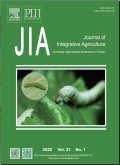首页|期刊导航|农业科学学报(英文)|Identification of S-Rnase genotype and analysis of its origin and evolutionary patterns in Malus plants
农业科学学报(英文)2024,Vol.23Issue(4):1205-1221,17.DOI:10.1016/j.jia.2024.01.014
Identification of S-Rnase genotype and analysis of its origin and evolutionary patterns in Malus plants
Identification of S-Rnase genotype and analysis of its origin and evolutionary patterns in Malus plants
摘要
关键词
Malus/S-RNase genotype/self-incompatibility/origin and evolutionKey words
Malus/S-RNase genotype/self-incompatibility/origin and evolution引用本文复制引用
Zhao Liu,Zichen Li,Qingshan Li,Lianwen Li,Dajiang Wang,Yuan Gao,Kun Wang,Jianrong Feng,Simiao Sun,Xiang Lu,Lin Wang,Wen Tian,Guangyi Wang..Identification of S-Rnase genotype and analysis of its origin and evolutionary patterns in Malus plants[J].农业科学学报(英文),2024,23(4):1205-1221,17.基金项目
This research was financially supported by the Agricultural Science and Technology Innovation Program(CAAS-ASTIP-2021-RIP-02). (CAAS-ASTIP-2021-RIP-02)

